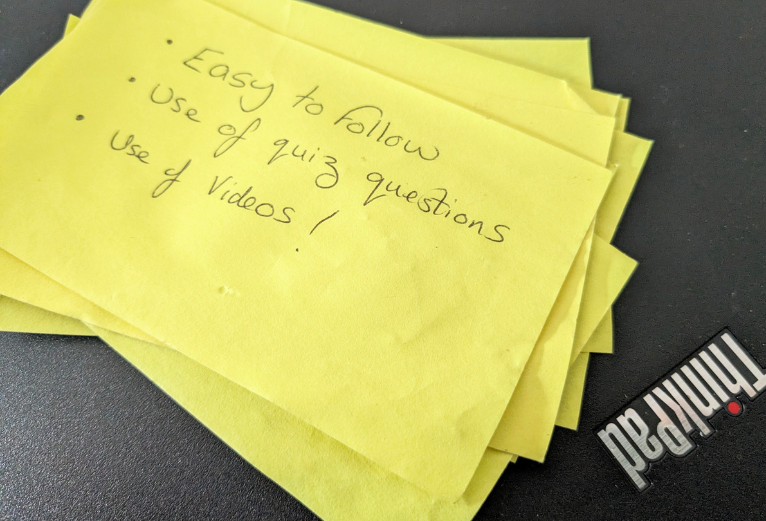Dr. Carolyn Voisey, Lecturer in Physiology
School of Pharmacy and Bioengineering, University of Keele, UK
Are you looking for a quick and efficient way to evaluate your teaching? Carolyn Voisey, a physiology lecturer and member of The Physiology Society, shares a simple method to help educators gain feedback from students to learn more about your own teaching style and methods. Carolyn’s adhesive approach enables teacher and student to work together, benefiting your students’ learning experience and your own teaching practice.

How DO you assess the effectiveness of your teaching? Or do you assess your students learning and use this as a measure to evaluate your own teaching? If like me you have recently read through the familiar format of the teaching evaluation questionnaire (student evaluation of teaching, SET) and muttered about the poor response rate, then read on.
The SET method
While a reasonable method to gauge student perceptions of learning, these questionnaires are controversial as the sole method of teaching quality evaluation (Kulik, 2001). Assessment allows us to evaluate how well our students have assimilated the material we provide, but does it really give us feedback on how well we teach?
A major drawback of the SET method lies in its timing; data collected at the end of the teaching period does little to persuade students to engage with the feedback as they perceive no benefit to themselves. An alternative method is for students to provide in-course/ongoing feedback, which should not only improve student perceptions of questionnaires, but would also serve as a powerful tool for reflection on our own practice (Mandouit, 2018).
Keeping it simple
Take a moment to consider this; how do we as academics assess our own personal effectiveness? As a lab-based scientist, reflective practice is something that I am well versed in when it comes to critically appraising my work in the lab, so transferring these reflective skills to my teaching practice shouldn’t be too difficult. Right?
As a student, I had a tutor who referred to the KIS approach – keep it simple. As a tutor, my time is swallowed up with the increasing demands of the job, so this is a must. Just like designing my teaching sessions, my intended learning outcomes (ILOs) for obtaining feedback needed to be determined. The method used needs to be simple, efficient in terms of time and student engagement in order for me to get the greatest value from it. It also must be collated and shared with my students (Al-Bashir, 2016). There before me, stuck to virtually every flat surface was the answer.
The post-it note.

And so it is that I have since approached a minimum of one teaching session per semester armed with a pile of these little colourful pieces of sticky paper. The premise is simple; each student takes a note and on one side writes an aspect of my teaching they have found useful/beneficial. On the reverse, shares something they have found unhelpful/would like me to change. As long as it was clear which was which, the entire time taken was a matter of moments. As they left the class they could stick the notes to the desk in front of me (sometimes with what might approach glee). I can then collect the notes and spend some time going through the suggestions and collating them. The method is anonymous, unless a student chose to put their name on their note, takes relatively little time to go through them and collate the responses. More often than not I am pleasantly surprised by them.
Active partners in the teaching/learning process
Most importantly, I can then give my students an overview of THEIR feedback on MY teaching at a time when it will directly benefit them. Despite not having the explicit knowledge of terms such as ‘pedagogy’, students are very capable of communicating what does and does not work for them. Working together in this informal manner has led to numerous developments that have not only been grounded in learner-centred pedagogical principles (Bremner, 2021) but which have improved student engagement, understanding and enjoyment of teaching sessions.
I challenge you to try it. By changing the way I obtain feedback, I have not only gained valuable insights into aspects of my practice that are working for my students but also those which I needed to alter. While students can find themselves overwhelmed by feedback at times (Brinko, 1993), having the opportunity to comment on my teaching at a point in the semester where they will personally benefit, motivates them to become active partners in the teaching/learning process. Surely, this can only benefit everyone as we strive to improve our students learning experience and our own practice.
References
Al-Bashir, M., Kabir, R., Rahman, I. (2016). The Value and Effectiveness of Feedback in Improving Students’ Learning and Professionalizing Teaching in Higher Education. Journal of Education and Practice, 7(16); 38-41
Bremner, N. (2021). The multiple meanings of ‘student-centred’ or ‘learner-centred’ education, and the case for a more flexible approach to defining it. Comparative Education, 57 (2), 159–186
Brinko, KT. (1993) The practice of giving feedback: What is effective? The Journal of Higher Education, 64 (5), 574-593
Kulik , JA. (2001) . Student ratings: validity, utility, and controversy. In The student ratings debate: are they valid? how can we best use them?, Edited by: Theall , M. , Abrami , P. C. and Mets , L.A. 9 – 25 . San Francisco, CA : Jossey‐Bass
Mandouit, Luke. (2018). Using student feedback to improve teaching. Educational Action Research. 26. 1-15.
